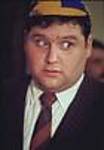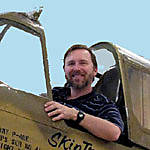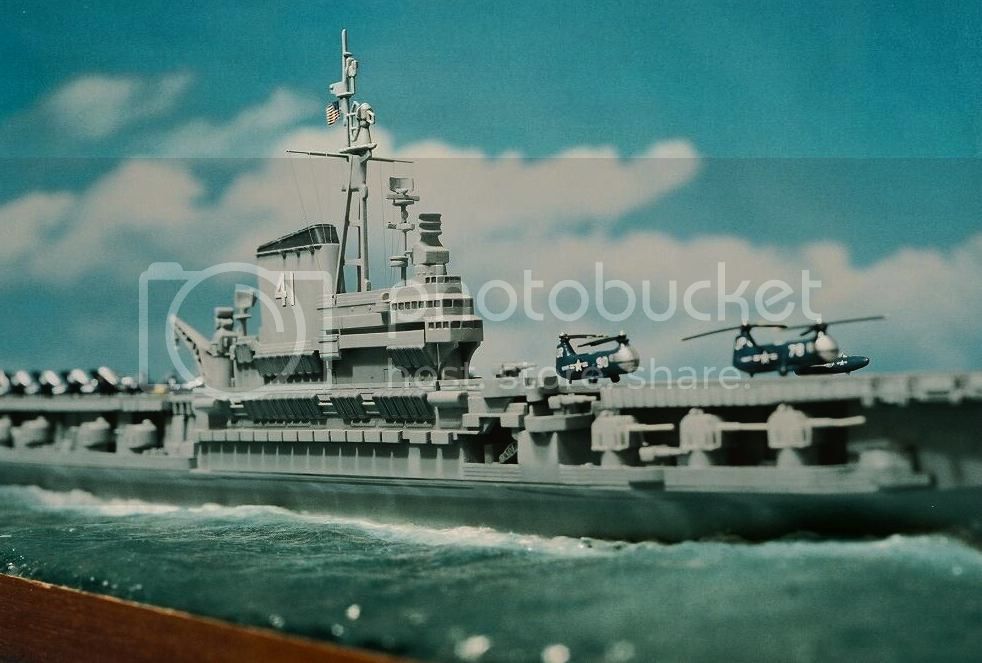You are viewing the archived version of the site.
Go to modelshipwrights.com for the current dynamic site!
Go to modelshipwrights.com for the current dynamic site!
Building Revell's USS Midway
5
Comments
Construction
I had bought the Midway quite a while ago but somehow never got started on it. Not that it was a bad kit; it just wasn’t one of those “must builds” for me that push everything else aside. Lack of references in my library, the odd scale, heavy detailing and lack of aftermarket goodies for it had eventually relegated the kit to the bottom of the model stash. More compelling projects always seemed to find their way to my workbench… but with a busy career, growing family and the increasing complexity of the projects themselves I found myself finishing fewer and fewer kits! With leisure time at a premium and my own ever-rising standards for build quality, was it still even possible to complete a good-sized scale model? Looking in my closet for a quick build, the relatively simple Midway seemed like a good choice. I resolved to put the model together right out of the box without worrying about less than perfect details and with no scratchbuilding, replacement parts, or photoetch allowed. It would be a straightforward, speedy build like when I was a kid (but without the bb guns and firecrackers!)
So I set to work. Just as aircraft builds usually begin with the cockpit, so ships begin with the hull. And that first step was also the first glitch in my plan. Revell’s rendition of the hull is pretty nice… except for that flat hull bottom. It is really very strange; this thing is not a true full hull, but it isn’t a proper waterline either. It is as if some giant were lifting the ship partially out of the sea, exposing about ¾ of the ship below the waterline but without taking it entirely from the water. No propellers or shafts are provided, and the twin rudders are actually cut in half to match the flat hull bottom. Even for a quick build, I just couldn’t live with that!
Waterlining the model was the easiest solution, so the first step was to cut away the underwater portion of the hull. Revell had thoughtfully included a raised waterline to assist painting, so I simply cut along this using my Dremel’s saw attachment. Ok, so the result was a little ragged, but that cut would be covered by the scratchbuilt ocean base to come later…Doh! There went my out of the box idea almost from the start! I guess if I kept it simple the base wouldn’t be that much more work…
With the hull thus summarily dealt with, the rest of the build went very fast. A mere eight parts built up the entirety of the exterior hangar deck bulkheads, with three more for the forecastle and aft main decks. These attached easily to the hull, quickly completing the structure up to flight deck level. No hangar deck is provided, but it didn’t matter since the various hangar doors are all depicted closed. The exception to this is at the portside elevator. On this one the hangar door is provided as a separate piece and the elevator includes a sliver of hangar deck about an inch deep. With an airplane outside on the elevator and the darkened space within you could probably get away with leaving the door open, but for simplicity I just left it closed.
In going for the simple build I had decided to ignore the crude 20mm Oelrlikon mounts cast into the sponsons as well as the molded-in railing along the edges of these parts, which I would have normally scraped off and replaced with photoetched brass. Although making for a much better scale appearance, this sort of thing also tends to bog down my projects for weeks, but not this time! I slid past, just taking time to clean flash off the parts and glue them down. It was the same with the island where again I left the molded-in railing and took time only to clean up the parts and conceal the seams. The tripod mast and radars also went on without alteration. Man, this was modeling! I couldn’t believe how much I was able to get done in a single afternoon!
The flight deck came next. This big part comes molded as a single piece with the centerline elevators, arrestor gear, catapults, tie-down points and other details all crisply molded in. Sure, the tie down points are raised dots instead of depressions and the dashed aircraft guide lines are raised outlines, but the details still look reasonably good. Best of all, the various galleries are cast directly onto the deck edge so there is no need for any assembly so it is just a matter of slapping it on and gluing it down.
Next comes the smaller details. Assorted bits such as anchors, cranes, and sensors, though by no means perfect, went on without enhancement. The 5 inchers came molded as single pieces, and the 3 inch twins attached to bases already cast directly onto the sponsons. These parts look only generally like the real things, but I didn’t let myself fuss over improving them either. Basic flash clean up and paint was all these little beauties got from me before they went aboard!
Paint and Markings
U.S. Navy ships of the 1950s were painted 5-H Haze Gray over all vertical surfaces, with darker 20-B Deck Blue or 20 Deck Gray over the decks. Aircraft carriers usually had 21 Flight Deck Stain, similar to Deck Blue, over their flight decks, but since the Midway class didn’t have wooden flight decks their armored steel flight decks were Deck Gray as well. In the spirit of keeping things simple I used Testors Model Master Dark Ghost Gray for Haze Gray and Model Master Gunship Gray for the decks. These colors were reasonable matches for Haze and Deck Gray right out of the bottle but, more importantly, I already had them on hand! These were brush painted on, starting with the light gray vertical surfaces followed by the darker decks. Recessed areas on the lighter gray vertical surfaces were then given pin washes of Gunship Gray, later drybrushed with the base color to tidy things up but still leave a bit of depth. The flight deck received a coat of Gunship Gray with the elevators receiving a slightly lightened color to help them stand out a little. Small details of the arrestor gear and catapults were picked out in the lighter gray. The aircraft guide lines on the flight deck were painted Floquil SP Armor Yellow. The repetitive process of painting these dozens of dashed lines was made much easier by Revell’s decision to represent them with raised outlines. All I had to do was to put a drop or two of thinned paint within the little rectangles and capillary action filled them in neatly and uniformly. Apparently the model had been designed with brush painters in mind!
At this point I wished I had one of the early releases of the Franklin D. Roosevelt which had the hull number “42” in raised outline on the funnel and flight deck. This would have made painting in those markings as easy as the dashed lines had been. As it was my model was one of the later issues from 1974, by which time Revell had removed these numbers from the molds. So instead the kit had come with decals for these areas: a pair of large yellow “41”s for the flight deck, shaded white ones for the funnel, and “MIDWAY” in large black letters for the stern. Unfortunately, the 35 year old decals in the box must have at some point become damp, because they were stuck solid to the backing paper and were unusable.
Replacing the shaded “41”s for the funnel was no problem. The Gold Medal Models 1/350-1/400 scale Naval Ship Decals, set 350-1D, contains perfectly sized shaded USN style numbers—they are even a little sharper than Revell’s decals would have been. The white “M-I-D-W-A-Y” letters for the fantail were also Gold Medal Models, in this case aircraft codes cut individually from a decal sheet for 1/350 scale USN WWII aircraft, set 350-6D. Like the kit decals these were slightly too big, but accurately scaled letters would have been almost invisible in this location anyway, so they worked just fine. For the yellow “41”s on the flight deck I painted a swatch of AP Armor Yellow over some spare solid decal sheet. Then, using the yellow “4’ and “1” numbers cut from the ruined Revell sheet, I traced the outlines on the painted over sheet, cut them out, and presto—new decals for the flight deck!
I refrained from any weathering as the Midway class carriers were the pride of the U.S. Navy of the time and were carefully maintained. Besides, it would have slowed things down, and this build was really cookin’ along!
Comments
An excellent presentation on both the ship and a classic kit!
The layout of the kit represents the Midway between 1946 and 1952. The original armored pilothouse was actually chopped off and the island forward of the funnel was completely replaced and the part of the flight deck that overhung the forecastle was actually cut back to produce an odd 'semi-hurricane bow'. In effect, the forward 3"-50's were left exposed but the rest of the forecastle was walled off, leaving secondary conn as a projecting bay-window. I recommend Pete Clayton's book on the Midway as an essential reference.
An interesting note about the flight deck colors: she was the first U. S. carrier to have an armored deck, so the steel was painted a dark deck gray, but then it was surmounted by thousands of black adhesive non-skid pads. These pads just touched one another end-to-end but were separated by 2-3 inches on the sides, producing a strange courderoy effect. How to paint that in 1/547 will be a challenge....perhaps decal film would work?
One advantage to working on the Midway is that you can still see vestiges of the ship's earlier layouts, especially on the hangar and flight deck levels. A 1:350 series on the Midways would be a welcome addition to the hobby.
--Karl
MAY 14, 2009 - 05:48 AM
Tim, great job! Brings back memories. Aside from the 3 inch twins, it would be make you look twice to tell it from some of the new models from the 1990s. And you are right about the aircraft - 1/350 planes made with a zillion parts, these old Revell skysteeds look pretty good when painted and decaled as well as you did. Salute!
JAN 30, 2015 - 07:08 PM
Copyright ©2021 by Tim Reynaga. _OPINIONS Model Shipwrights, KitMaker Network, or Silver Star Enterrpises. Images also by copyright holder unless otherwise noted. Opinions expressed are those of the author(s) and not necessarily those of Model Shipwrights. All rights reserved. Originally published on: 2009-05-14 00:00:00. Unique Reads: 22868










